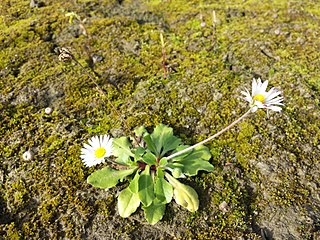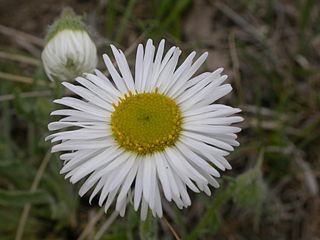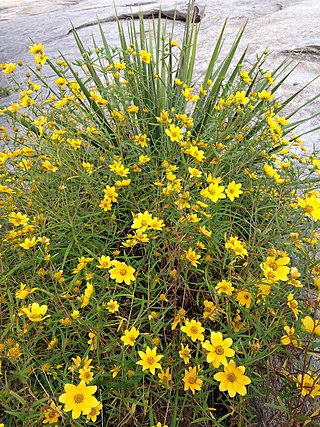
Glebionis segetum is a species of flowering plant in the family Asteraceae, probably native only to the eastern Mediterranean region but now naturalized in western and northern Europe as well as China and parts of North America. Common names include corn marigold and corn daisy.

Rudbeckia hirta, commonly called black-eyed Susan, is a North American flowering plant in the family Asteraceae, native to Eastern and Central North America and naturalized in the Western part of the continent as well as in China. It has now been found in all 10 Canadian Provinces and all 48 of the states in the contiguous United States.

Symphyotrichum novae-angliae is a species of flowering plant in the aster family (Asteraceae) native to central and eastern North America. Commonly known as New England aster, hairy Michaelmas-daisy, or Michaelmas daisy, it is a perennial, herbaceous plant usually between 30 and 120 centimeters tall and 60 to 90 cm wide.

Bellis perennis, the daisy, is a European species of the family Asteraceae, often considered the archetypal species of the name daisy. To distinguish this species from other plants known as daisies, it is sometimes qualified or known as common daisy, lawn daisy or English daisy.

Symphyotrichum is a genus of over 100 species and naturally occurring hybrids of herbaceous annual and perennial plants in the composite family, Asteraceae, most which were formerly treated within the genus Aster. The majority are endemic to North America, but several also occur in the West Indies, Central and South America, as well as one species in eastern Eurasia. Several species have been introduced to Europe as garden specimens, most notably New England aster and New York aster.

Dimorphotheca sinuata, the glandular Cape marigold, Namaqualand daisy, or orange Namaqualand daisy; syn. Dimorphotheca aurantiaca hort.) is a species of plant native to southern Africa. It is also widely cultivated as an ornamental and naturalized in parts of the United States, primarily California and Arizona.

Erigeron compactus is a species of flowering plant in the family Asteraceae known by the common names cushion daisy, fernleaf fleabane, and compact daisy.

Erigeron foliosus, known by the common names leafy daisy and leafy fleabane, is a North American species of flowering plants in the family Asteraceae.

Erigeron strigosus is a species of flowering plant in the family Asteraceae known by the common names prairie fleabane, common eastern fleabane, and daisy fleabane.

Layia is a genus of flowering plants in the family Asteraceae known generally as tidy tips, native to western North America. Several are California endemics.
Calycadenia fremontii is a species of flowering plant in the daisy family known by the common name Frémont's western rosinweed. It is native to southwestern Oregon and northern California. It is a common member of the flora in several types of habitat in the mountains, foothills, and valleys. This annual plant is variable in appearance.

Astranthium, or Western-daisy, is a North American genus of flowering plants in the family Asteraceae. Astranthium is native to the United States and Mexico.

Townsendia condensata is a species of flowering plant in the family Asteraceae known by the common names cushion Townsend daisy and cushion townsendia. It is native to North America where it is known from many scattered occurrences in the mountains of the western United States and Alberta in Canada. It is mainly limited to the alpine climates of high mountain peaks, where it grows in meadows, tundra, and barren, rocky talus. It grows alongside other alpine plants such as Eriogonum androsaceum.

Astranthium integrifolium, the entireleaf western daisy or eastern western-daisy, is a North American species of flowering plants in the family Asteraceae. It is native to the east-central part of the United States primarily the Cumberland Plateau and Ohio/Tennessee Valley. It is found in the States of Tennessee, Kentucky, Alabama, and Georgia, with isolated populations in Mississippi and West Virginia.
Astranthium robustum, the Texas western-daisy, is a North American species of flowering plants in the family Asteraceae. It is found only in the western (trans-Pecos) part of the US State of Texas.
Boltonia caroliniana, common name Carolina doll's-daisy, is a North American species of plants in the family Asteraceae. It is found only in the southeastern United States, primarily in the states of North Carolina, South Carolina, and Virginia with a few isolated populations in western Georgia.

Erigeron ochroleucus is a North American species of flowering plant in the family Asteraceae, called the buff fleabane or buff daisy. It is native to western Canada and the western United States from Alaska and Yukon southeast as far as Colorado and Nebraska.

Erigeron subtrinervis, called the three-nerved daisy, the three-nerve fleabane, or the hairy showy daisy, is a North American species of flowering plants in the family Asteraceae. It grows in various mountains of western Canada and the western United States: Rocky Mountains, northern Cascades, Black Hills, etc., from British Columbia and Washington state east to North Dakota and south as far as New Mexico.

Helianthus porteri is a species of sunflower known by the common names Porter's sunflower, Stone Mountain daisy and Confederate daisy. The term "daisy" is imprecise because the species is a sunflower (Helianthus) rather than a daisy. Likewise, although the plant grows on Stone Mountain, GA, its range extends well beyond. The connection to the Confederacy is through Stone Mountain which contains a confederate monument, although the connection is tenuous as the species was named before the Civil War in 1849 by Harvard botanist Asa Gray in honor of Thomas Conrad Porter, a Pennsylvanian minister and botanist who collected the plant in Georgia. Gray initially named the plant Rudbeckia porteri, later changed to Helianthus in 1998 by John F. Pruski.

Symphyotrichum ciliatum is a species of flowering plant in the family Asteraceae native to North America and eastern Eurasia. Commonly known as rayless annual aster and rayless alkali aster, it is an annual, herbaceous plant that may reach over 70 centimeters in height. Each flower head has many whitish then pink disk florets and no ray florets ("rayless").
















